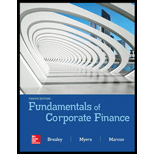
a.
To compute:
a.
Explanation of Solution
The formula to calculate return on equity is as follows:
The calculation of return on equity is as follows:
Hence, the ROE is 13%
b.
To compute:
b.
Explanation of Solution
The formula to calculate return on asset is as follows:
The calculation of return on capital is as follows:
Hence, the ROA is 6.04%
c.
To compute: Return on capital (ROC)
c.
Explanation of Solution
The formula to calculate return on capital is as follows:
The calculation of return on equity is as follows:
Hence, the ROC is 10.20%
d.
To compute: Days in inventory.
d.
Explanation of Solution
The formula to calculate days in inventory is as follows:
.
The calculation of days in inventory is as follows:
Hence, the days in inventory is 21.40 days
e.
To compute: Inventory turn over
e.
Explanation of Solution
The formula to calculate inventory turnover is as follows:
The calculation of inventory turnover is as follows:
Hence, the inventory turnover is 19.11
f.
To compute: Average collection period(ACP)
f.
Explanation of Solution
The formula to calculate average collection period is as follows:
The calculation of average collection period is as follows:
Hence, the ACP is 68.89 days.
g.
To compute: Operating profit margin (OPM)
g.
Explanation of Solution
The formula to calculate operating profit margin is as follows:
The calculation of operating profit margin is as follows:
Hence, the OPM is 12.64%
h.
To compute: Long term debt ratio
h.
Explanation of Solution
The formula to calculate operating profit margin is as follows:
The calculation of long term debt ratio is as follows:
Hence the long term debt ratio is 0.42
i.
To compute: Total debt ratio
i.
Explanation of Solution
The formula to calculate total debt ratio is as follows:
The calculation of total debt ratio is as follows:
Hence the total debt ratio is 0.65
j.
To compute: Times interest earned
j.
Explanation of Solution
The formula to calculate times interest earned is as follows:
The calculation of times interest earned is as follows:
Hence the time interest earned is 3.75
k.
To compute: Cash coverage ratio
k.
Explanation of Solution
The formula to calculate cash coverage ratio is as follows:
The calculation of cash coverage ratio is as follows:
Hence the cash coverage ratio is 7.42
l.
To compute: Current ratio
l.
Explanation of Solution
The formula to calculate current ratio is as follows:
The calculation of current ratio is as follows:
Hence the current ratio is 0.74
m.
To compute: Quick ratio
m.
Explanation of Solution
The formula to calculate quick ratio is as follows:
The calculation of quick ratio is as follows:
Hence the quick ratio is 0.52
Want to see more full solutions like this?
Chapter 4 Solutions
FUNDAMENTALS OF CORPORATE FINANCE
- Chee Chew's portfolio has a beta of 1.27 and earned a return of 13.6% during the year just ended. The risk-free rate is currently 4.6%. The return on the market portfolio during the year just ended was 10.5%. a. Calculate Jensen's measure (Jensen's alpha) for Chee's portfolio for the year just ended. b. Compare the performance of Chee's portfolio found in part a to that of Carri Uhl's portfolio, which has a Jensen's measure of -0.25. Which portfolio performed better? Explain. c. Use your findings in part a to discuss the performance of Chee's portfolio during the period just ended.arrow_forwardDuring the year just ended, Anna Schultz's portfolio, which has a beta of 0.91, earned a return of 8.1%. The risk-free rate is currently 4.1%, and the return on the market portfolio during the year just ended was 9.4%. a. Calculate Treynor's measure for Anna's portfolio for the year just ended. b. Compare the performance of Anna's portfolio found in part a to that of Stacey Quant's portfolio, which has a Treynor's measure of 1.39%. Which portfolio performed better? Explain. c. Calculate Treynor's measure for the market portfolio for the year just ended. d. Use your findings in parts a and c to discuss the performance of Anna's portfolio relative to the market during the year just ended.arrow_forwardNeed answer.arrow_forward
 Essentials Of InvestmentsFinanceISBN:9781260013924Author:Bodie, Zvi, Kane, Alex, MARCUS, Alan J.Publisher:Mcgraw-hill Education,
Essentials Of InvestmentsFinanceISBN:9781260013924Author:Bodie, Zvi, Kane, Alex, MARCUS, Alan J.Publisher:Mcgraw-hill Education,

 Foundations Of FinanceFinanceISBN:9780134897264Author:KEOWN, Arthur J., Martin, John D., PETTY, J. WilliamPublisher:Pearson,
Foundations Of FinanceFinanceISBN:9780134897264Author:KEOWN, Arthur J., Martin, John D., PETTY, J. WilliamPublisher:Pearson, Fundamentals of Financial Management (MindTap Cou...FinanceISBN:9781337395250Author:Eugene F. Brigham, Joel F. HoustonPublisher:Cengage Learning
Fundamentals of Financial Management (MindTap Cou...FinanceISBN:9781337395250Author:Eugene F. Brigham, Joel F. HoustonPublisher:Cengage Learning Corporate Finance (The Mcgraw-hill/Irwin Series i...FinanceISBN:9780077861759Author:Stephen A. Ross Franco Modigliani Professor of Financial Economics Professor, Randolph W Westerfield Robert R. Dockson Deans Chair in Bus. Admin., Jeffrey Jaffe, Bradford D Jordan ProfessorPublisher:McGraw-Hill Education
Corporate Finance (The Mcgraw-hill/Irwin Series i...FinanceISBN:9780077861759Author:Stephen A. Ross Franco Modigliani Professor of Financial Economics Professor, Randolph W Westerfield Robert R. Dockson Deans Chair in Bus. Admin., Jeffrey Jaffe, Bradford D Jordan ProfessorPublisher:McGraw-Hill Education





